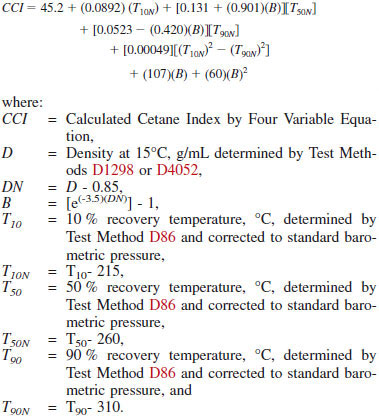3. Summary of Test Method
3.1 Two correlations in SI units have been established between the ASTM cetane number and the density and 10 %, 50 %, and 90 % distillation recovery temperatures of the fuel. Procedure A has been developed for diesel fuels meeting the requirements of Specification D975 Grades No. 1-D S15, No. 1-D S500, No. 1-D S5000, No. 2-D S5000, and No. 4-D. The relationship is given by the following equation:

3.2 The empirical equation for Procedure A of the Calculated Cetane Index by Four Variable Equation was derived using a generalized least squares fitting technique which accounted for measurement errors in the independent variables (fuel properties) as well as in the dependent variable (cetane number by Test Method D613). The data base consisted of 1229 fuels including; commercial diesel fuels, refinery blending components and fuels derived from oil sands, shale, and coal. The analysis also accounted for bias amongst the individual sets of data comprising the database.
3.3 Procedure B has been developed for diesel fuels meeting the requirements of Specification D975 Grade 2-D S15 and No. 2-D S500. The relationship is given by the following equation:
CCI = 2386.26(D) + 0.1740(T10) + 0.1215(T50) + 0.01850(T90) + 297.42(2)
where:
CCI = Calculated Cetane Index by Four Variable Equation
D = Density at 15°C, g/mL determined by Test Methods D1298 or D4052
T10 = 10 % recovery temperature, °C, determined by Test Method D86 and corrected to standard barometric pressure
T50 = 50 % recovery temperature, °C, determined by Test Method D86 and corrected to standard barometric pressure
T90 = 90 % recovery temperature, °C, determined by Test Method D86 and corrected to standard barometric pressure
3.3.1 The equation for Procedure B when T10, T50, and T90 are in °F is:
CCI = 2386.26(D) + 0.09668(T10) + 0.06751(T50) + 0.01028(T90) + 291.83
where:
CCI = Calculated Cetane Index by Four Variable Equation
D = Density at 15°C, g/mL determined by Test Method D1298 or D4052
T10 = 10 % recovery temperature, °F, determined by Test Method D86 and corrected to standard barometric pressure
T50 = 50 % recovery temperature, °F, determined by Test Method D86 and corrected to standard barometric pressure
T90 = 90 % recovery temperature, °F, determined by Test Method D86 and corrected to standard barometric pressure
3.4 The empirical equation for Procedure B of the Calculated Cetane Index by Four Variable Equation was derived from National Exchange Group data for 87 No. 2-D S15 and No. 2-D S500 diesel fuels with sulfur level between 16 and 500 ppm using a Partial Least Squares technique. A 2-principal component model was chosen. The model was validated with a set of 980 diesel fuels with sulfur levels in the same range.
4. Significance and Use
4.1 The Calculated Cetane Index by Four Variable Equation is useful for estimating ASTM cetane number when a test engine is not available for determining this property directly and when cetane improver is not used. It may be conveniently employed for estimating cetane number when the quantity of sample available is too small for an engine rating. In cases where the ASTM cetane number of a fuel has been previously established, the Calculated Cetane Index by Four Variable Equation is useful as a cetane number check on subsequent batches of that fuel, provided the fuel's source and mode of manufacture remain unchanged.
4.2 Within the range from 32.5 to 56.5 cetane number, the expected error of prediction of Procedure A of the Calculated Cetane Index by Four Variable Equation will be less than ±2 cetane numbers for 65 % of the distillate fuels evaluated. Errors may be greater for fuels whose properties fall outside the recommended range of application.



